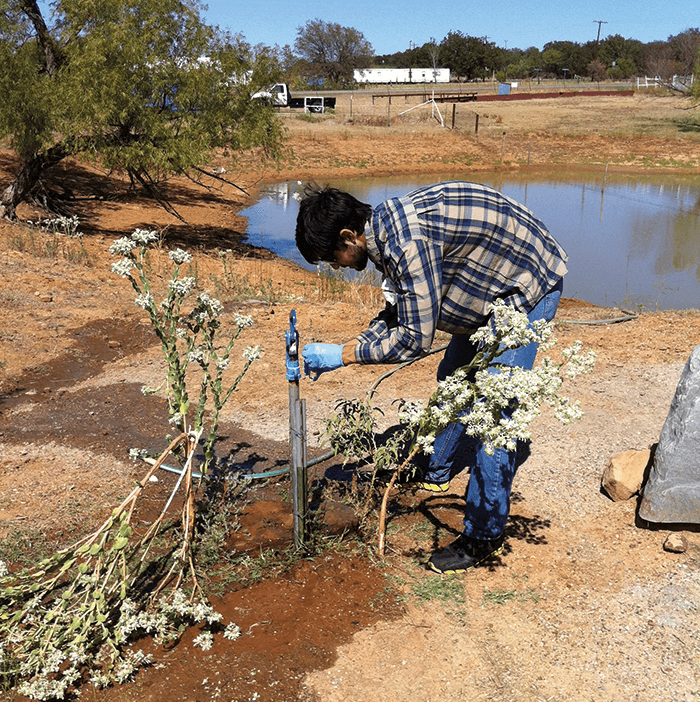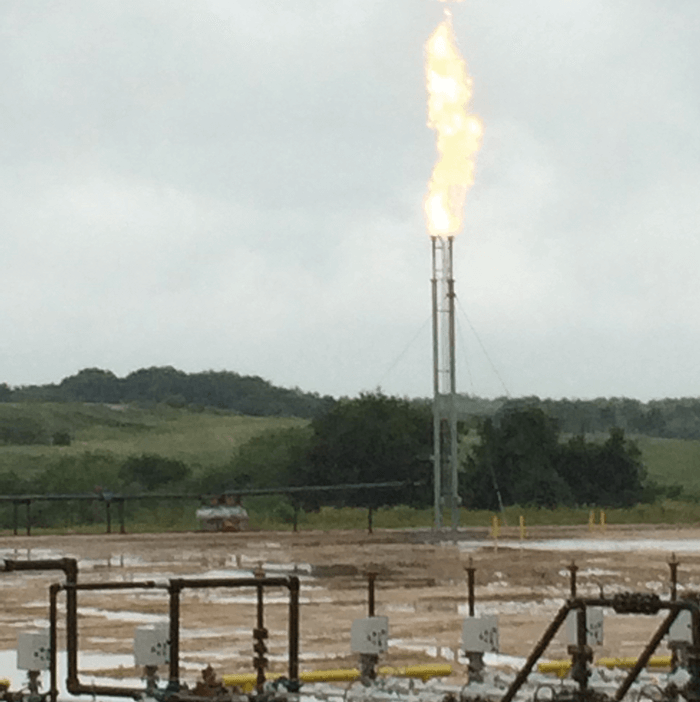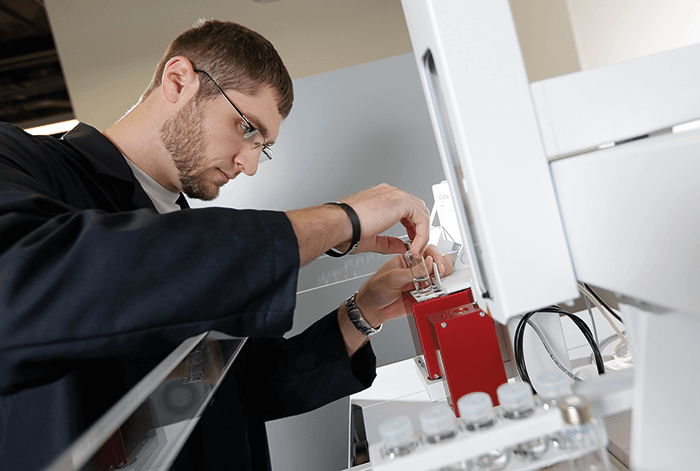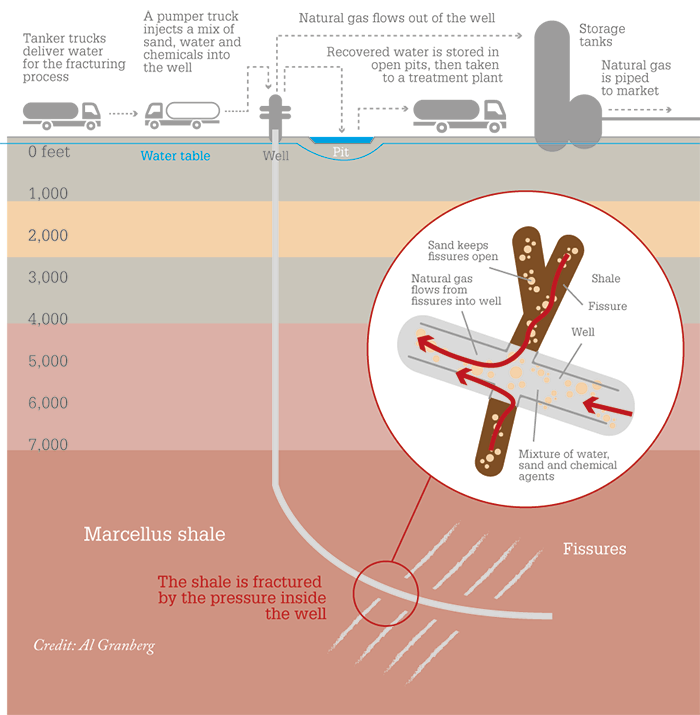In recent years, the US has seen a boom in unconventional oil and gas development (UD), including hydraulic fracturing, to extract oil and gas. Energy companies claim that it is safe, clean, and necessary if the US wants to ensure essential power supplies in the coming decades. However, environmental activists have raised concerns that fracking is contaminating local water and air. Imagine you are a landowner in a rural community. An energy company representative comes to you and explains that your land contains oil or gas, and that you could be making “money for nothing”. You sign the contract, thinking of how the money could benefit your family. Months later, dozens of heavy tractor trailers begin rumbling through narrow rural roads; the landscape and community begins to change. Change brings about uncertainty, which often leads to doubt. The unease is further fueled by a raft of conflicting information and propaganda online. You find yourself reading a forwarded email from your grandmother, with a picture of someone lighting their well water on fire, while in the background an American Petroleum Institute commercial booms “This ain’t your daddy’s oil” (1). During these confusing times, a health, environmental, or lifestyle change occurs and our minds tend to go immediately to the new kid on the block – fracking. Could a mystery illness or a change in your well water be the result of that contract you signed all those months ago? The energy company says one thing, environmental groups say the opposite – who do you believe?
Our environmental research has been an attempt to combat this uncertainty through objective science. As an academic research lab with a primary expertise in analytical chemistry, we felt we had a chance to investigate and communicate in a manner that other labs or government agencies struggled with.
Tools of the trade
In the Spring of 2011, a couple of Dallas-Fort Worth area scientists walked into Kevin Schug’s office at the University of Texas at Arlington (UTA). Zacariah Hildenbrand (then a postdoc and now at Inform Environmental, LLC) and Brian Fontenot (an independent consultant) had become curious about the effects of the rapid expansion of UD across this highly populated region. Their backgrounds in quantitative biology and biochemistry meant they had adequate design of experiment and participants, but no strong analytical support for the project. Kevin rarely says no to new research, especially research involving a gap in fundamental knowledge (or new toys!). As the only graduate student in Kevin’s lab with gas chromatography (GC) experience, it became my “little side project”. Six years on, I’m full-time Project Manager of what is now known as the Collaborative Laboratories for Environmental Analysis and Remediation (CLEAR; see “Making it CLEAR” below).



A Beginner’s Guide to Fracking
Hydraulic fracturing, known as fracking, is a technique to extract natural gas or oil trapped in underground rock formations (e.g., shale gas). A large volume of water, mixed with solid particles (proppants) and chemicals, is injected at high pressure into a well to create cracks in the rock, releasing oil and gas. The particles (sand or aluminum oxide) in the mixture lodge in the fractures, holding them open. Horizontal drilling is often used to maximize the volume of rock reached.

We soon found that many standard methods, like US Environmental Protection Agency (EPA) drinking water methods or toxicology panels, fall short in terms of covering the exotic and/or undisclosed nature of the chemicals used in UD. Testing methods for industrial practices are designed to look for known targets, whether aged diesel from spills or heavy metal emissions from coal and cement plants. Shale extraction environmental research is still in its infancy in the US and there is no set list of proven chemical indicators, malpractice or unsafe releases specific to unconventional drilling. Regulations are left to each state and typically consist of traditional metrics from the EPA, National Institute for Occupational Safety and Health (NIOSH), or Occupational Safety and Health Administration (OSHA). Many of these measurements are collected over an 8- or 24-hour period, which risks underestimating short-term, high-level exposures of gases like hydrogen sulfide or carbon disulfide.
There is a massive burden of proof placed upon researchers investigating indications of UD impact, which is why we use multiple complementary measurements to validate detections. For example, high chloride and bromide measurements within a groundwater sample should be associated with a higher conductivity, and dissolved gas in groundwater should pair with an elevated total organic carbon (TOC) value. Our conclusions are still firmer when we can measure changes over time. An example of this would be arsenic measurements we made over 13 months on a ranches in West Texas (6). One water well had a significant amount of arsenic, more than double that allowed by EPA drinking water standards. Had we relied on only one time point, we may have been led to focus on identifying the source of the arsenic in this one well, but analyzing the well over time showed us that arsenic levels did not fluctuate as drilling increased, so we could rule out UD as a factor for the arsenic levels.
Unconventional Drilling: Impacts
With any large-scale industrial process, you expect changes in the immediate surroundings. However, the impacts experienced in areas of unconventional drilling have been much broader than many residents or
experts anticipated.
The benefits to communities include an influx of tax revenue locally, increased sales of food and other commodities, and infrastructure upgrades. However, extraction is a multi-week, multi-stage operation with a localized increase of people and traffic, bringing noise pollution, increased vehicle emissions, damage to roads and an influx of temporary workers. Environmental impacts can include VOC emissions from equipment to store and move oil and gas (10,11), surface water impairment from waste water spills (12), and potentially impairment of groundwater (13), all of which can have negative health effects.
Many of the impacts, positive or negative, come with any petroleum recovery operation, but risks that are unique or exaggerated with hydraulic fracturing include spills of produced water (drilling wastewater surfacing while the well is producing oil or gas), silica dust, large quantities of chemicals being stored at each pad, and truck traffic hauling water pre- and/or post-injection. The disposal of the resulting waste water in injection wells is also thought to increase the risk of earthquakes.
Though much attention has been focused on water, one of the greatest concerns for me is air quality. Ever since the electron capture detector was developed, the scientific and regulatory communities have become privy to the gases in our atmosphere. If forced, people can drink bottled water or change how they use their land, but we cannot “ship in” fresh air. Technology already exists to mitigate emissions – remote methane monitors, flare scrubbers, silica dust containment, to name just a few – but currently all monitoring and capturing technologies are voluntary.
Last year we published an emissions study investigating BTEX emissions of the various equipment found on active pad sites, with the University of North Texas (10). A mobile mass spectrometer allowed us to directly tie emissions to a particular location or machine on a pad site and showed that emissions from a particular location were not ubiquitous to all the pad sites and could be reduced with machinery upgrades or alternatives. For example, H2S scrubbers powered with diesel fuel generated more BTEX emission than those using alcohol-based fuel. I hope studies like these will help regulators prioritize improvements that protect our most precious resource – the air we breathe.
Zooming in
Our research began around 2011 with samples taken across large areas of the Barnett (2)(3) and Eagle Ford (4)(5) shales, which gave us a general idea of the water quality but could not provide the spatial resolution needed to identify localized areas of concern. At this early stage of UD research, we didn’t know whether we were looking for widespread or localized impacts.
As we collected those initial samples, we began hearing accounts from landowners about perceived changes in the surroundings, environmental quality, or personal health. We were shown running well water on fire, bubbling puddles that never dry, home foundation issues, and even copies of death certificates across a neighborhood. It was then that we realized that conspiracy theorists (often ordinary people driven by desperation) keep great lab notebooks. These events seemed to be happening in localized areas, limited to a neighborhood or two. Since our shale-wide surveys did not observe uniform or systematic anomalies, we thought greater information might be obtained from sampling more targeted regions over extended timeframes.
Our first time-course study was conducted in west Texas, in the expanding Cline Shale of the Permian Basin. One of our Barnett shale participants informed us that he and neighbors had leased portions of their ranches for multiple oil wells, but that drilling had not yet started to a significant degree in the nearby area. One criticism leveled at our earlier studies was that there were no adequate UD-specific baseline groundwater measurements for quaternary amines, zirconium salts, and biocides used in proprietary fracking mixtures. This West Texas area was an amazing opportunity to sample before, during, and after UD. When we started the study in December 2012, only one oil well had been developed; by January 2014, there were a total of 12 oil wells within 5 km of the 42 water wells we sampled. We observed a drastic pH increase across the majority of the wells, various VOCs, and increased bromide concentrations (6).

Neutral and objective
The publication of these results caused a considerable stir, with a lot of “spin” from all sides of the debate on fracking. Conservation groups took the results as direct evidence of fracking contaminating groundwater, while one industry-led blog touted the report as evidence that many of these perturbations are short-term. While we are often amazed at how our work is interpreted (and misinterpreted), we believe that there is some truth in the old adage “any press is good press”.
We find that responding to these agenda-driven interpretations is best done in person if possible. Though this is not always practical, we have made an effort to attend and present at many public conservation meetings and industry-focused conferences. I’m sure many scientists would cringe at the thought of discussing such a contentious topic with the public, but it has sometimes led to valuable research and donation leads. For example, a fracking watchdog nun, Sister Elizabeth Riebschlaeger, whom our sampling team met in the Eagle Ford shale region, pointed us to Balmorhea, a desert oasis in far West Texas. After discussions with local residents about planned drilling in what came to be known as the “Alpine High” field, we launched a crowdfunding campaign to raise funds to collect baseline data around these coveted springs. The campaign caught the attention of Apache Corporation, the lease holders for the area, who offered to fund a year’s worth of water monitoring and laboratory research related to their drilling operations.
The opportunity for us, as academic chemists with no oilfield experience, to discuss general operations, experimental design, and compounds to target has been phenomenal. These days, we can find out what the bottom hole pressure and temperatures are in the Permian Basin with a quick phone call, rather than a lengthy literature search. Other times we hang up from a call with a notebook full of suggested target compounds, based on the company’s understanding of breakdown reactions or cross-reactions with other additives in the mixtures. The open dialog has given us a better understanding of the processes at work, and access to the best locations for sampling. And the company has improved its reputation in the region.
Some see the acceptance of the Apache Corp donation as “selling our souls”, but we don’t believe that receiving industry funding is incompatible with our neutral and objective stance. Donated funds cannot be tied to contractual deliverables, and we are the sole owners of the data. About a month earlier, we received a donation from Earth Day Texas, a conservation organization. Research conducted through funding by both entities will be peer-reviewed and published.
Making it CLEAR
The mission of CLEAR is to examine environmental and human health impacts of industrial processes, and develop better technology to detect and remediate industrial contamination.
The lab specializes in testing and monitoring of groundwater and surface water quality in proximity to unconventional oil and gas extraction sites.
CLEAR team members and collaborators are also developing technologies to enable detection and remediation of harmful contaminants that pose a danger to human health, and cultivate the responsible management of natural resources.
Coming together
Fracking is not going away anytime soon in the US – the financial return is too high. When oil prices collapsed in late 2014, it was easy to see how important the industry was to the economies of states like Wyoming, Oklahoma, Alaska, and North Dakota. Unemployment increased, equipment was abandoned as it became too expensive to operate, and companies filed for bankruptcy.
But we badly need more research into the environmental and health impacts of unconventional drilling. It remains difficult for researchers to gain permission from operators to access pad sites, details of proprietary mixtures of initial fluids, or samples of flowback or produced water (typically sent for disposal by deep well injection). Lack of funding is another major issue. The UD process is complex and entangled with other industrial activities, so definitively conclusive findings are unlikely – not something that attracts grant-giving organizations. Plus, government funding is likely to be limited by the potential negative effects on the country’s economy if fracking proves to have undesirable consequences. Therefore, it’s likely that private donations will remain the main funding source for our group. We hope that by working with both environmentalist groups and energy companies, we might act as an information bridge between the two sides.
Recently, we took that ethos a step further and did something almost radical: we held a two-day conference with presentations and panel discussions by academic and government researchers, oil and gas regulating officials, industry employees, and conservationists, all open to the public for free. The Responsible Shale Energy Extraction Symposium and Exposition (7) was part of Earth Day Texas 2017, and coordinated with support from EARTHx (formally Earth Day Texas) and the Cynthia and George Mitchell Foundation, both forward-thinking organizations concerned with sustainability and solutions for environmental problems. The meeting was opened by the US Secretary of Energy Rick Perry and saw presentations on health, climate change, chemical disclosure, water use, monitoring technology, and best management practices by operators (8).
Reflections
The past six years have been quite a ride. I’ve traversed the shale plays of the USA, visited Hugh Heffner-style swimming pools built with fracking royalties, met conservationist nuns and members of the Professional Rodeo Hall of Fame, and collected samples ranging from the tail hair of a deceased racehorse to mysterious gray bubbling fluid in a coffee can.
Strange Samples
Samples collected by members of the public have proved valuable to us on several occasions and have found their way into our scientific presentations (9) and manuscripts. Some of the more unusual samples we’ve been offered over the years have included:
- Vacuum cleaner waste
- Orange water
- Flammable water
- Hair samples taken from the hairbrush of a deceased relative
- Gray fluid that spurted from the ground like a fountain
- Filters from air conditioning units from across an entire neighborhood
- Tail hair from a thoroughbred racehorse
- Fish (bass) caught in the landowner’s pond
Though some of the situations we find ourselves in are funny in the re-telling, we are sensitive to the fact that the homeowners we work with are often in genuine despair. Consumed by the damage they feel is being done to themselves, their families and their land, it’s difficult for them to accept that they may never get a clear answer. It’s hard to communicate to unsuspecting owners that levels of metals or chemicals in their well water are above those set by the EPA for safe drinking water. But it can be even harder to tell sick homeowners that even though we did all of our fancy tests, we can’t tell them why they can’t breathe.
For those who are being affected by the impact of UD, our remediation arm aims to help, but developing strategies and products takes far more time than generating data. We are also an academic institution, which ultimately means that our students need to be conducting original, innovative research. We have begun working with various technology firms assessing the effectiveness of their water treatment processes. Recent projects have included a new method for BTEX analysis in soil and characterization of the ability of a commercial household filter to remove organic and inorganic constituents of drilling-produced water. Progress can feel slow, but we hope to eventually be able to work with energy companies, local residents and environmentalists alike to monitor, mitigate and ultimately prevent adverse effects.
Doug Carlton Jr. is Project Manager, Collaborative Laboratory of Environmental Analysis and Remediation (CLEAR), The University of Texas at Arlington, USA.
References
- M Tadeo, “API launches power past impossible campaign during super bowl showing natural gas and oil benefit to consumers in everyday life”. Available at: http://bit.ly/2ld9JCj. Accessed August 30, 2017.
- BE Fontenot et al., “An evaluation of water quality in private drinking water wells near natural gas extraction sites in the Barnett Shale Formation”, Environ Sci Technol, 47, 10032–10040 (2013).
- ZL Hildenbrand et al., “A comprehensive analysis of groundwater quality in the Barnett Shale Region”, Environ Sci Technol, 49, 8254–8262 (2015).
- ZL Hildenbrand et al., “A reconnaissance analysis of groundwater quality in the Eagle Ford Shale Region reveals two distinct bromide/chloride populations”, Sci Total Environ, 575, 672–680 (2017).
- ZL Hildenbrand et al., “A Corrigendum to ‘A reconnaissance analysis of groundwater quality in the Eagle Ford Shale Region reveals two distinct bromide/chloride populations’”, Sci Total Environ, 603–604, 834–835 (2017).
- ZL Hildenbrand et al., “Temporal variation in groundwater quality in the permian basin of texas, a region of increasing unconventional drilling activity”, Sci Total Environ, 562, 906–913 (2016).
- Responsible Shale Energy Extraction Symposium & Exposition. Available at: https://www.shalescience.org. Accessed August 30, 2017.
- UTA CLEAR YouTube Channel. Available at: http://bit.ly/2wShhnI. Accessed August 30, 2017.
- DD Carlton Jr et al., “Environmental forensics analysis in proximity to unconventional drilling activity: air and soil contamination study initiated through amateur documentation and collection”. Presented at 62nd ASMS Conference on Mass Spectrometry and Allied Topics; June 4-8, 2017; Indianapolis, USA. Presentation ThP 557.
- ZL Hildenbrand et al., “Point source attribution of ambient contamination events near unconventional oil and gas development,” Sci Total Environ, 573, 382–388 (2016).
- BF Payne et al., “Characterization of methane plumes downwind of natural gas compressor stations in Pennsylvania and New York”, Sci Total Environ, 580, 1214–1221 (2017).
- NR Warner et al., “New tracers identify hydraulic fracturing fluids and accidental releases from oil and gas operations environ”, Sci Technol, 48, 12552–12560 (2014).
- ZL Hildenbrand et al., “Temporal variation in groundwater quality in the Permian Basin of Texas, a region of increasing unconventional drilling activity”, Sci Total Environ, 562, 906–913 (2016).




